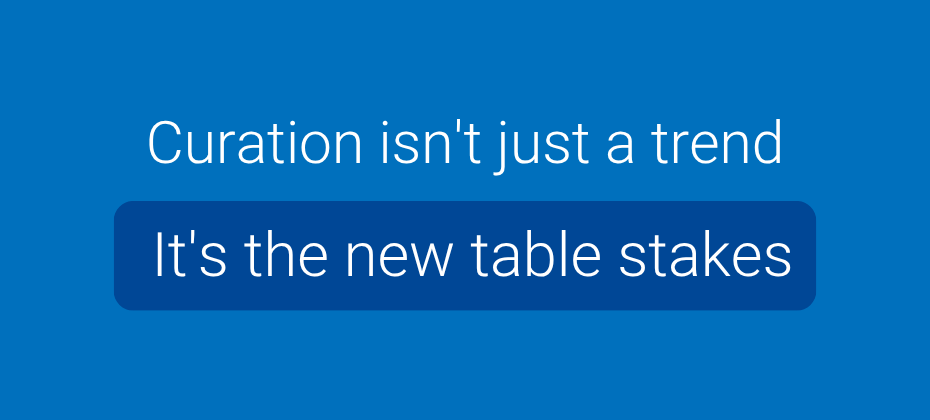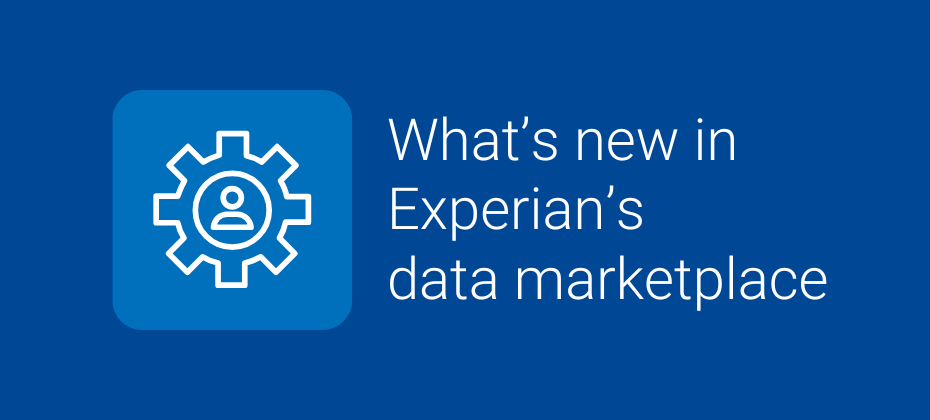All posts by Hayley Schneider, Sr. Manager, Content Marketing

Supply-side platforms (SSPs) are expected to deliver more than inventory—they’re being asked to support sell-side targeting strategies, campaign results, and proof of performance. To meet that demand, SSPs need more than access to inventory. They need better data, better tools, and a way to bring it all together. Experian’s solutions for SSPs We built Experian’s solutions for SSPs with that demand in mind. By combining identity resolution, audience targeting, and third-party measurement, we help platforms move beyond basic transactions. Whether you’re doing sell-side targeting, supporting direct deals, or looking to support campaign validation, our tools make it easier to create value for buyers—and keep them coming back. Our solutions that help SSPs: Resolve identity across digital touchpoints using our industry-leading Digital Graph Build differentiated audiences using over 2,400 Experian Audiences and Partner Audiences in Audience Engine Support advertiser-direct relationships with tools to create, activate, and host custom segments Measure real outcomes like in-store visitation and sales through Outcomes, our third-party validated reporting suite Together, these capabilities allow SSPs to produce data-driven deals, increase addressability, and meet buyer demand for smarter, more measurable media. Campaign snapshot: Yieldmo + Experian Yieldmo, an advertising platform known for its creative formats and data-informed approach, has already put this solution to work. Here’s how they built a custom strategy for a major athletic retail client using Experian's solutions for SSPs. The challenge: Drive in-store traffic and reach new buyers Yieldmo supports a leading athletic retailer’s seasonal campaigns focused on in-store traffic. This advertiser wanted to reach new buyers—specifically those who might otherwise shop with a competitor. To do this, they needed access to strong audience segments with reliable data and the flexibility to act quickly across channels. This was the first time Yieldmo applied Experian Audiences to this retailer’s campaigns. The stakes were high: the client was looking for better in-store outcomes and a more streamlined activation workflow. The solution: Experian's activation solution for SSPs Using Experian’s Audience Engine, which includes our proprietary and third-party data marketplace, Yieldmo built a flexible, high-performing media plan that spanned display inventory and included both conquesting and primary in-store shopper segments. The team selected and activated: Apparel and footwear audiences built from Experian and partner data providers In-store shopper segments targeting retail behavior signals Competitive purchasers to capture likely buyers from other athletic brands Our data marketplace allowed Yieldmo to combine Experian Audiences with Partner Audiences from providers like Alliant, Circana, Sports Innovation Lab, and Webbula—all in one place. Manual audience creation used to take days. Now, Yieldmo can build and activate campaigns through a streamlined, self-serve workflow. By working in the Audience Engine platform, Yieldmo was able to avoid multiple contracts and manual requests. They filtered audiences by brand, tailored segments to their goals, and launched without delays. “Experian’s data marketplace in Audience Engine fills a critical gap—letting us quickly search by brand, build smarter conquest segments, and activate custom audiences fast.”Abby Littlejohn, Director of Sales Planning, Yieldmo The results: Expected lift in store visits While final in-store lift results are pending, the early performance metrics are promising: Click-through rates are at and above historical benchmarks across both conquesting and primary shopper segments. Using Audience Engine’s self-serve tools, Yieldmo created audiences faster and more easily. They reduced their workload by minimizing the need for manual data wrangling. “We include Experian audience segments in 80% of formal RFPs. Between contract simplicity, data quality, and campaign results, Experian has become our go-to for third-party audience targeting.”Nelson Montouchet, AVP, Strategic Partnerships, Yieldmo Download the full case study Bring this to your platform Whether you’re looking to monetize more effectively, build deeper advertiser relationships, or stand out with sell-side targeting offerings, we designed Experian’s solutions for SSPs to do exactly that. With our industry-leading Digital Graph, over 2,400 syndicated audiences, partner data, flexible self-serve tools, and outcome-based measurement, SSPs can now move faster and go further—without compromising scale or precision. Get in touch with our team Latest posts

After another week under the sun at Cannes Lions 2025, one thing is abundantly clear: our industry is done talking about possibilities — it’s ready to act. From speaking engagements to packed suite meetings, and even stateside through our “Can’t Cannes” activations, the appetite for change was real — and we were right at the center of it. A front-row seat to innovation Experian made a powerful impact across the Croisette, partnering with Audiostack, Basis, Infillion, IQVIA, Magnite, NextRoll, Odeeo, OpenX, The Female Quotient, and the Unplugged Collective x The Digital Marketer, to contribute to some of the week’s most insightful conversations. Our thought leaders were everywhere—on stage, in studio interviews, at executive roundtables—offering a clear voice on retail media growth, pharma advertising disruption, AI innovation, and identity-driven personalization. Three themes that defined the week 1. AI gets real If 2024 was the year of AI buzz, then 2025 is the year AI found its footing. Conversations shifted from “what if” to “what now.” While the promise of AI was front and center, conversations with clients and partners highlighted that we’re still in the foundational phase. Real-world applications—from creative optimization to predictive segmentation—are gaining traction, but long-term value will depend on robust data architecture and trustworthy identity frameworks. MiQ and PMG debuted AI-integrated platforms that demonstrated how AI can automate creative, optimize budget allocation, and personalize media in real time. AI has moved from sidekick to strategist. "Last year it was all about AI, but in a very general sense. This year, it’s about specific applications — a clear sign AI is evolving from a talking point into product.”Budi Tanzi, VP, Product 2. Outcomes > impressions Outcomes may have been a buzzword at Cannes, but as several industry leaders pointed out, simply saying “we drive outcomes” isn’t enough—it risks sounding like table stakes. In today’s performance-driven environment, what matters is how companies define and deliver those outcomes in unique ways. The most compelling conversations weren’t about generic promises, but about clear strategies: challenging assumptions, leaning into strengths, and making specific choices that tie data, media, and technology to measurable impact. "By using consistent identity across planning, activation, and measurement, marketers can connect ad exposure to real-world outcomes—whether that’s an online conversion, an in-store visit, or a new customer relationship."Chris Feo, Chief Business Officer 3. Curation isn't just a tactic Curation is quickly becoming the industry’s preferred approach to cutting through complexity. As marketers contend with signal loss and inconsistent inventory quality, the shift from broad access to intentional activation is gaining momentum. At Experian, we see curation not just as packaging, but as strategic alignment—where identity, data, and inventory come together in purpose-built environments that reduce waste, enhance safety, and drive performance. "Supply-side data activation and optimization, aka “curation,” is an alternative to the traditional approach to data activation. Unlike the traditional DMP-to-DSP activation flow, curation allows buyers to leverage supply-path data more directly. The upshot? Improved performance and pricing for media agencies and brand advertisers."Drew Stein, Managing Director, Audigent Bringing the Cannes experience stateside Not everyone can make it to the South of France—so we brought Cannes to them. Our “Can’t Cannes” events in the U.S. offered local clients a first-class experience filled with insights and networking, minus the jet lag. Final takeaways This year’s festival made one thing clear: real progress requires more than innovation; it requires integration. And that’s where Experian is focused—connecting identity to activation, and data to outcomes, in ways that are practical, scalable, and privacy-resilient. If I had to sum it up? AI is progressing from abstract to application Curation beats clutter Partnership is power And everyone’s aligned around performance We’re grateful to have been part of these conversations and even more excited about where they’ll lead next. Let’s continue the conversation If you're exploring how to connect identity to performance, or simplify the way you activate, measure, and grow, we’d love to talk. Latest posts

Originally appeared in AdExchanger Google’s decision not to deprecate cookies in the Chrome browser after all caused a stir across the industry. Companies invested heavily in developing solutions aligned with the Privacy Sandbox as a survival tactic for the post-cookie landscape. At first glance, Google’s about-face may appear to undercut those efforts. It’s easy, and perhaps even satisfying for some – but inaccurate – to say “all that effort was for nothing.” Given Chrome’s dominance among browsers, AdTech companies had no choice but to prepare for “what if” scenarios. The same goes for cookie deprecation. Google’s plan to end support for third-party cookies would have removed a mechanism that has been a cornerstone of addressability for the past 15 years. To be clear, those efforts have not been wasted. They spurred innovation across the AdTech landscape, driving progress in privacy-first targeting, alternative identifiers, supply-path data activation, and real-time data enrichment – all of which will pay dividends for years to come. Whether born directly from Privacy Sandbox participation or inspired by the broader trend toward privacy reform, industry-wide preparation for cookie loss and browser disruption has yielded tangible benefits. Pressure from Google, Apple, and evolving regulations served as a catalyst for modernization that could shape the next decade of advertising technology. An industry anchored in product innovation AdTech is a fundamentally product-driven industry defined by short innovation cycles and the imperative to build and test rapidly. This DNA enables companies to stay resilient, evolve and deliver innovation. Change is good. Disruption can be even better – but only for those who embrace it. Google’s evolving stance on cookies and Privacy Sandbox doesn’t negate what’s been learned. If anything, it underscores the need to keep innovating. The next wave of disruption is likely right around the corner. The payoff While some may argue that the time and effort spent preparing for cookie loss was wasted, those efforts have functioned as a forcing mechanism for several innovations in data activation. Supply-side data activation and optimization, aka “curation,” is an alternative to the traditional approach to data activation. Unlike the traditional data management platform (DMP) to demand-side platform (DSP) activation flow, curation allows buyers to utilize supply-path data more directly. The upshot? Improved performance and pricing for media agencies and brand advertisers. As curation continues to evolve, it’s poised to play a central role in how advertisers and publishers transact. Real-time data enrichment is another area that has benefited from this period of accelerated innovation. Many companies were compelled to improve their tech stacks to align with Sandbox protocols. These updates, particularly in real-time data enrichment capabilities, are now laying the groundwork for future data activation strategies across both the buy and sell-sides. Exiting out of tunnel vision Over the past five years, the AdTech industry has invested deeply in planning for a future without cookies. Still those investments have been well worth it. While cookies are not going away, the broader deprecation of signal continues. The work that was done to prepare will inevitably inform the next evolution of our industry. Contact us Latest posts

Marketers are under more pressure than ever to deliver personalized, high-performing campaigns—while navigating tighter budgets, shifting privacy expectations, and fragmented tech stacks. Despite an explosion of tools and data sources, the fundamentals of marketing haven’t changed. Every great campaign still starts with a simple question: Who are we trying to reach? The answer depends on how well you understand your customers. Increasingly, that understanding is hampered by data silos, inconsistent identity signals, and disconnected workflows between planning, activation, and measurement. When those pieces don’t align, it leads to inefficient spending, incomplete insights, and missed opportunities. To move forward, marketers need more than better tools—they need a more connected approach. Start with a complete view of the customer The foundation of effective marketing is understanding your audience—not just who they are, but what they care about and how to reach them across devices and platforms. That starts with building a complete customer profile. For many marketers, this means linking persistent offline data—such as name and address—with fresh digital signals like device IDs and online behaviors. When combined, these elements provide a high-fidelity view of the customer that can be enriched with attributes like demographics, purchase behavior, and lifestyle interests. This kind of profile doesn’t just help you understand people—it helps you build audience segments that actually perform. Whether you’re working with your own CRM data or third-party sources, the ability to create addressable segments that are both accurate and scalable is what separates good campaigns from great ones. 🛳️ That’s exactly what MMGY did for Windstar Cruises. By layering first-party data with behavioral and demographic insights, they built custom audiences that more than doubled campaign benchmarks. 🎮 Gaming platform Unity tapped into Experian audiences to understand player behaviors across web, mobile, and connected TV (CTV). These insights helped their advertisers reach gaming audiences more effectively—tailoring creative and delivery to real-world preferences, not assumptions. Activate with precision, not just volume Knowing your audience is only half the battle. The next challenge is reaching them—consistently and efficiently—across multiple channels. This is where fragmentation can creep back in. All too often, marketers build audiences in one system, but activate in another, causing data loss and targeting mismatches. A more connected strategy uses the same identity and audience spine across planning and activation, reducing signal loss and improving accuracy. 👉 Curated private marketplaces (PMPs), for example, allow marketers to match high-quality audiences with premium inventory in a targeted, transparent, and efficient way. These deals let marketers align their spending with their goals—whether that’s lowering cost-per-acquisition or boosting reach in a key vertical. Performance results are bearing this out: PMG By using Audigent’s curated PMP approach in combination with Experian audience data, they delivered campaigns that were 44% more cost-efficient across CTV. Boiron For Boiron, a homeopathic brand, using curated media buying reduced data costs by 30% and beat CPA goals for both video and display by more than 40%. Index Exchange Publishers benefit, too. When Index Exchange included Audigent-curated inventory in their PMPs, they saw an average 70% revenue lift for mobile and a 13% lift for CTV. When identity, audience, and inventory are aligned, everyone benefits—marketers, publishers, and consumers. Measure what matters Too often, measurement is treated as an afterthought. But in a connected campaign, it’s built in from the beginning. By using consistent identity across planning, activation, and measurement, marketers can connect ad exposure to real-world outcomes—whether that’s an online conversion, an in-store visit, or a new customer relationship. This kind of closed-loop measurement turns marketing into a learning engine. You don’t just see what happened—you understand why it happened and can use that information to improve the next campaign. 🛳️ In the case of Windstar Cruises, MMGY used Experian identity to precisely measure how digital ad exposures translated into bookings. That kind of visibility gives marketers more than a report card. It gives them the feedback they need to optimize smarter next time—and prove ROI every time. The future is connected To meet today’s demands, marketers need a new way of working—one that starts with a complete understanding of the customer, builds addressable audiences on a strong identity foundation, activates them precisely across channels, and measures impact in real time. The marketers embracing this approach are already seeing results: stronger performance, more efficient spending, and deeper insights that power what comes next. The future won’t be built on more tools—it will be built on more connection. Connect with us Latest posts

Curation — the intelligent packaging of data and inventory actionable in a private marketplace deal — can no longer be considered a trend or buzzword. With over 66% of all open exchange – representing $100 billion in annual spend – being transacted through private marketplace deals (PMPs), curation is a key part of how data and identity are addressed and actioned in programmatic media. Programmatic advertising is certainly known for big shifts, but as shared by Index Exchange CEO Andrew Casale, “Curation will be bigger than header bidding and as big as programmatic or real-time bidding (RTB) - that’s our bet.” And we agree. But why has curation become a critical component of brands and media agencies' digital advertising strategies? Put simply, the math. Case study after case study empirically shows curation performs well for both the buy and sell-sides. For media agencies and brands, curation consistently shows four main benefits: Significant cost efficiencies Buying curated PMPs shows significant cost efficiencies when compared to buying data from the buy-side alone. Strong performance Data-enriched, curated PMPs can be optimized through the supply path, unlike a data management platform (DMP) segment, which leads to strong performance. Futureproofs media buying When data is curated through the supply path, it does not need to rely on legacy identifiers (like cookies), and the door is open to robust, next-gen addressability which better futureproofs media buying opportunities. Value-added insights Curation comes with robust log-level data that can be used for value-added data science including analytics, insights, reporting, and attribution – all critical in a world where addressability and identity resolution are becoming even more challenging. Curation introduced efficiency into homeopathic brand Boiron’s media buys, reducing the brand’s data costs by 30%, which enabled the brand to reinvest the same budget in brand awareness goals. Curation not only met but also exceeded the CPA for display by 82% and for video by 41%. “Audigent has been a top 5 performer in terms of CPA during our testing, helping our teams deliver 44% more efficient spend for brands across CTV campaigns."Sam Bloom, Head of Partnerships at agency PMG A big boost for addressability Legacy identity signals are changing. Whether it’s by browser, device, or platform, both buy-side and sell-side platforms need strong identity signals to reach their intended audiences, and this has become harder than ever before. Curation, with its real-time data connection and enrichment capabilities, solves signal loss challenges by directly connecting to the supply path and using a broader spectrum of identity solutions to boost addressability. Curation allows platforms to target first-party, third-party, contextual, indexed and modeled audiences. This alleviates the dependence on any one identifier and boosts the relevant bidding opportunities for brands and media agencies to target audiences. Not all curation is created equally As with any hot innovation, AdTech is notorious for companies jumping on the bandwagon of the largest trends. Curation is no different, with seemingly everyone now claiming to be a “curator.” As the industry works to define what is and isn’t “curation," we are uniquely positioned to define this as Audigent has pioneered curation for seven years and is the industry leader. The definition of curation is the intelligent packaging and optimization of data curated against the inventory supply path. There are three definitional elements to any curation product: Unique audience data Curation must include first-party, third-party, contextual, indexed and/or modeled data. Robust SSP integration To apply data in real-time to the inventory supply path, a curator must have deep partnerships and integrations that enable the combination of data and inventory into a single package. Optimization The whole point of curating data against the supply path is that it opens the door for robust real-time optimization to drive performance. If the solution ticks all three boxes, then brands and agencies should test curation and gauge its results firsthand. Curation done right drives results for brands, agencies, and publishers When done well, curation improves media buying efficiency and performance for brands and agencies. Importantly, it also drives results for publishers and content creators. Advertisers realize average data segment savings of 36-81% when using PMPs over the open exchange (Internal data) Advertisers see 10-70% lower CPC, 1.5x-3.0x higher CTR, and 10-30% higher video completion rate when using data-enriched PMPs over the open exchange (Internal data) When including their inventory in curated PMPs, publishers see an average 70% revenue uplift for mobile and 13% for connected TV (CTV) Beyond voting with budgets, media agencies and brands are also weighing in on the curation conversation: “Our Conditions Marketplace strategies have driven a 48% improvement in eCPM and a 26% improvement in CPA across our pharma client portfolio as of May 2024. For one client, we saw ROAS improve by 58% compared to their overall omnichannel performance while maintaining quality. These results aren’t outliers—they’re proof that curation is no longer a nice-to-have; it’s a must-have for marketers who want performance, precision, and scale working in lockstep.”Amanda DeVito, Butler/Till Industry-leading curation with Experian Tapping into an end-to-end solution that enables marketers to understand and reach their desired customers across channels through curation is a win-win for all parties. In the past three years, Experian and curation company Audigent have delivered a range of industry-leading innovations together, including the integration of Experian data into Audigent’s PMPs. As one company now, Experian's unique identity and data capabilities amplify how curation activates on the buy-side at scale, setting a new standard for audience targeting with added benefits like audience customization and flexible activation through Audigent’s PMPs or demand-side platforms. Connect with us Latest posts

Audio platforms that overcome consumer identity challenges are winning new advertisers and driving higher ROAS. In this article, you’ll hear from leading audio platforms that are solving these challenges—and seeing results. Digital audio is evolving fast. What was once a niche channel of host-read sponsorships and direct buys is now a must-have in the modern media mix. Streaming platforms, podcasts, and digital radio are drawing more ad dollars thanks to audio’s ability to capture attention and connect with listeners. But with growth comes new pressure. Advertisers expect accuracy, scale, and to see results. At the same time, listeners want more relevant content and more personalized ad experiences. That’s where identity becomes essential. With Experian’s identity and audience solutions, audio platforms can: Bolster addressable audience targeting and personalization capabilities. Gain a comprehensive view of listeners’ digital identity to reach audiences across channels. Better understand consumer preferences, enabling advertisers to reach audiences with greater accuracy. Enhance the listening experience with more relevant content. Let’s break down the key challenges in audio—and how Experian can help solve them. Challenge 1: Anonymous listening limits addressability Most listening happens in environments where people aren’t logged in—via apps, smart speakers, and mobile devices. Without logged-in data, platforms struggle to know who’s listening and advertisers are unable to reach those anonymous listeners who don’t have an addressable ID. To overcome the identity gap in unauthenticated listening environments, leading audio platforms are turning to partners that connect fragmented signals—like device type, location, and behavioral patterns—to broader household and individual profiles. By using hashed emails and other alternative identifiers, platforms can begin to make anonymous sessions more addressable. This increase in addressability ensures the platform’s entire userbase can be reached, which leads to an increase in revenue. Experian’s solution Experian's identity spine, comprised of our Digital and Offline Graphs, helps you recognize listeners even when they’re outside your ecosystem. Platforms like Audacy are already leading the way. By integrating Experian’s Digital Graph, they’re gaining a more complete view of listeners’ digital identifiers—enhancing the experience across their app and website. With a better audience understanding, Audacy can deliver personalized content while helping advertisers reach specific groups with greater accuracy. Challenge 2: IP-based targeting falls short Audio has traditionally relied on IP addresses, but that’s no longer enough. A single IP could represent an entire household—or a public setting like a coffee shop. It’s not precise. Forward-thinking platforms are moving beyond IP-based targeting by integrating identity resolution technologies that combine household-level data with device-level intelligence. These solutions help distinguish between shared devices and individual listeners, allowing advertisers to serve more relevant messages without over-reliance on a single signal like an IP address. This layered approach improves precision—especially in dynamic listening environments like vehicles or communal spaces. Experian’s solution Our identity spine links home IPs to households, then connects them to specific devices and individuals. This helps platforms move beyond basic IPs and target real people based on accurate signals—even in shared listening environments like smart speakers and cars. We also help platforms and advertisers integrate alternative IDs—like Unified I.D. 2.0 (UID2)—into their programmatic audio campaigns. That means more reach, without compromising consumer trust. Challenge 3: Audio buying is fragmented From podcasts to streaming to radio, audio lacks consistency in how inventory is packaged and bought. It’s hard for advertisers to run scaled campaigns across channels—and harder still to measure performance. Plus, advertisers don’t think in silos—they think in strategies. If audio can’t connect to their display, connected TV (CTV), and social buys, it loses ground. What they need is a way to define audiences once and activate everywhere. To reduce friction in audio ad buying, platforms are investing in infrastructure that unifies audience insights across formats. By building a centralized view of the listener—regardless of whether they're tuning in via podcast, stream, or radio—publishers can offer advertisers consistent targeting parameters, clearer reporting, and better campaign orchestration. Identity graphs and audiences are playing a growing role in streamlining this complexity and unlocking scale. Experian’s solution Experian helps simplify audio buying. Experian audiences are built on top of our identity graph and are expanded to a deep set of digital identifiers, ensuring accuracy, scale and maximum addressability across channels. Platforms can blend their first-party data with advertiser data and our audiences—then deploy those audiences onsite or activate programmatically across open web and CTV. DAX is doing just that. DAX's partnership with Experian combines Experian’s 2,400+ audiences for targeting and activation with DAX’s innovative audio advertising approach. We’re helping advertisers connect with passionate and engaged listeners nationwide. "Through our partnership with Experian Marketing Services, advertisers can unlock deeper audience insights and execute more impactful digital audio campaigns. By combining our shared market presence, knowledge, and forward-thinking approach, we’re strengthening our digital audio network offering and delivering value to all our advertising partners." Brian Conlan, President of DAX United States In addition to integrating Experian’s Digital Graph, Audacy is also integrating Experian's syndicated audiences to unlock accurate insights like demographics, shopping behavior, and interests - providing listeners with a more personalized advertising experience and advertisers with a higher return on investment. “Historically, audio advertising lacked precise targeting capabilities, making it challenging for advertisers to reach specific audiences. By integrating our digital identity graph and syndicated audiences with Audacy’s platform, we’re transforming how advertisers connect with listeners. This collaboration enables more effective audience targeting and delivers personalized, impactful audio experiences across all channels.”Chris Feo, Chief Business Officer, Experian Privacy is non-negotiable Everything we do is privacy-forward by design. Backed by Experian’s Global Data Principles and decades as a regulated institution, we rigorously vet every data source to ensure compliance with all federal and state laws. Build an audio strategy that performs with Experian Your advertisers want more from their audio investments. With Experian, you can give it to them. We help you: Expand digital addressability to maximize reach for marketers and drive revenue growth for your platform. Create and activate addressable audiences across all channels. Enhance the listening experience with relevant content and personalized ads. Audio has always been a powerful way to connect. Now, it’s ready to perform. Let's connect Latest posts

When we launched our data marketplace earlier this year, we set out to transform how the industry discovers and activates privacy-safe audiences and maintains addressability across display, mobile, and connected TV (CTV). Yieldmo was one of the first adopters and their story speaks volumes about what’s possible when flexible tech meets premium data. Large retail brand boosts in-store traffic with Yieldmo and Experian Yieldmo, an advertising platform known for its inventive, AI-powered creative formats and privacy-first inventory, partnered with Experian to support a leading athletic retailer’s campaign focused on driving in-store traffic. The goal? Attract in-store shoppers likely to purchase from competitors, particularly during key sales windows. Using Experian’s Audience Engine platform, which includes our proprietary and third-party data marketplace, Yieldmo built a high-performing, self-serve targeting strategy that included both conquesting and in-store shopper segments. With the ability to easily combine Experian Audiences and Partner Audiences, like those from Alliant, Circana, Webbula, and Sports Innovation Lab, Yieldmo quickly built precise apparel and footwear audiences. Using Experian’s identity graphs in Audience Engine, Yieldmo increased cross-channel addressability to maximize campaign scale and impact. “Experian’s data marketplace in Audience Engine fills a critical gap, letting us quickly search by brand, build smarter conquest segments, and activate custom audiences fast. The platform is flexible and the support is hands-on and reliable.”Abby Littlejohn, Director of Sales Planning at Yieldmo With self-serve setup that cut down manual work, the ability to build highly tailored audiences, and expected lift in store visits, Experian helped the team achieve standout results. "We selected Experian as our primary third-party data partner based on contract ease, audience quality, and speed. Through Experian, we can find high-performing audiences from multiple providers that meet our client’s targeting objectives. We include Experian audience segments in 80% of formal RFP proposals and are in active discussions on how to optimize for future campaigns—making Experian a go-to partner for third-party targeting.”Nelson Montouchet, AVP, Strategic Partnerships, Yieldmo More data, more reach: Experian’s data marketplace fuels smarter targeting across ad platforms Today, just months after launch, Experian’s data marketplace is gaining traction across the ecosystem. Over 10 platforms, including leading supply-side platforms (SSPs) and TV platforms such as Madhive, OpenAP, and Optimum, are now actively utilizing our data marketplace to enhance their activation capabilities. As privacy rules tighten and many identity signals start to fade, a lot of activation platforms are finding it tougher to reach their audiences. This is where our data marketplace shines, with one of the most comprehensive identity graphs out there, 126 million households, 250 million individuals, and over four billion active digital IDs, we make it easy to activate audiences while keeping addressability high across channels. We preserve accuracy when scaling to digital IDs via our identity graphs since Experian is rooted in offline data, which provides better connections and smarter targeting. “Our long-standing partnership with Experian and breadth of Experian's data marketplace, combined with the interoperable, direct matching methodology of our Open Identity solution, make it possible for OpenAP to enable advertisers and agencies to use best-in-class data partners to build audiences with the highest fidelity and consistently reach audiences at scale wherever they are consuming content across premium video.”Chris LoRusso, Chief Business Officer at OpenAP Experian’s data marketplace has grown to include over 20 premium data providers, such as: “We’re thrilled to bring PlaceIQ’s privacy-first, visit-based audiences to Experian’s marketplace, giving brands quick and easy access to high-intent shoppers. From recent big-box customers to yoga-studio regulars, advertisers can add real-world relevance to campaigns across every channel.”Brian Bradtke, Head of Partner Development, Precisely PlaceIQ These partnerships bring unique value to platforms looking to understand and engage audiences more effectively, whether through physical location intelligence, sports and fandom insights, or behavioral intent signals. What’s next We're focused on expanding our data ecosystem and helping platforms and marketers turn fragmented data strategies into a unified competitive advantage. If Yieldmo’s story is any indication, this is just the beginning. Let’s connect and explore how Experian’s data marketplace can help you drive more revenue, scale your audience reach, and stay ahead of privacy shifts. Connect with us Latest posts

Retail media networks (RMNs) are on the brink of a major shift. While they are poised to capture over 20% of ad spend in 2025, on-site monetization won't be the growth driver it once was. With advertisers consolidating spend among just six or seven RMNs on average, including giants like Amazon and Walmart, it’s hard for smaller RMNs to compete. Off-site retail media ad spend is projected to grow 42.1% in 2025 - nearly three times the rate of on-site growth (15.1%), according to eMarketer's November 2024 forecast. This dramatic shift underscores that while on-site placements are maturing, off-site is where the momentum (and money) is heading. To remain competitive, RMNs must move beyond traditional, on-site placements and embrace a broader, more integrated approach to media activation. The future of retail media is about utilizing enriched first-party data to drive performance across the open web, connected TV (CTV), and other digital channels. Break free from your owned and operated properties Historically, RMNs have limited ad placements to their own digital properties. While this approach has delivered high-margin returns - on-site ad margins can reach 70-90%, compared to 20-40% for off-site - it’s also inherently limiting. Retailers only have so much owned inventory to sell, and advertisers demand greater scale and flexibility. As brands push for more reach, RMNs must extend their impact beyond owned-and-operated (O&O) properties. Omnichannel retail media ad spending is forecast to hit $61.2 billion in 2025. Brands are looking beyond retail sites to build integrated, multi-channel strategies that drive results across the funnel.eMarketer Off-site doesn’t just mean digital. Walmart’s recent expansion of its Fuel and Convenience stations - planning to open or remodel 45 in 2025, bringing the total to 450 - shows how physical spaces are also becoming extensions of a retailer’s media network. These locations create new touchpoints where advertisers can engage shoppers with timely, context-aware messaging while they fuel up or grab a snack. These quick-stop environments are ideal for limited-time offers or impulse-triggering messages - especially since 68% of U.S. adults say discounts contribute to their latest in-store impulse purchase. Maximize the value of first-party data One of retail media’s biggest promises is the power of first-party data for precision targeting. While on-site ads are inherently lower-funnel, off-site activation allows advertisers to move up the funnel and apply retailer customer data holistically across the open web. For example, DoorDash and Macy’s now offer self-service audience data to advertisers via The Trade Desk, allowing brands to target consumers programmatically. Meanwhile, Walmart is taking a different approach - cloning The Trade Desk’s technology to maintain its walled garden. These moves demonstrate how retailers are rethinking data monetization strategies to scale beyond O&O limitations. Drive new revenue streams with off-site activation Off-site activation enables RMNs to drive incremental reach on channels where audiences are actively engaging, including CTV, programmatic display, and social media. This expansion allows brands to connect with consumers beyond retail websites. Retailers are also utilizing non-endemic advertising opportunities in environments like gas stations and kiosks. Unlike traditional grocery or apparel aisles, these spaces are brand-neutral, allowing advertisers who don’t sell products in-store to still activate campaigns using retailer data. In fact, 53% of brands have already partnered with a retailer that doesn’t carry their product, and that number is expected to grow as advertisers seek new ways to tap into retail media’s rich targeting capabilities. Retailers looking to extend the value of their data beyond O&O inventory have two primary off-site opportunities: First, they can use an identity graph to resolve customer identifiers into addressable IDs that can be enriched with additional attributes and activated across channels like the open web and CTV. This allows retailers to find and reach known customers with relevant messaging outside of their owned platforms. For example, a grocery RMN can identify lapsed snack buyers and deliver streaming TV ads that reengage them on CTV platforms. CTV retail media ad spending alone is expected to grow 43.1% this year, reaching $4.86 billion, highlighting the appetite for video-based upper-funnel strategies. Second, RMNs can broaden reach by activating first-party audiences, syndicated segments, or custom-built audiences through onboarding capabilities. These audiences can be sent to a variety of programmatic and CTV destinations, enabling advertisers to engage shoppers in high-impact environments. For example, a home improvement retailer can send its audience segments to programmatic ad exchanges, ensuring DIY shoppers see relevant offers even while browsing unrelated sites. Together, these approaches allow retailers to monetize their data more effectively while giving brands the ability to reach consumers in moments that matter beyond just retail websites and apps. Scale and measure success with data partnerships For smaller RMNs to compete with larger players, they need more than just inventory - they need the ability to scale campaigns and prove performance. Data partnerships play a critical role in both expansion and measurement. Measurement remains one of the biggest challenges for RMNs moving off-site. On-site retail media offers closed-loop attribution, but off-site activations introduce complexity. Retailers can work with an identity resolution partner like Experian to connect ad exposures to actual retail outcomes, such as store visits or purchases, across digital and physical environments. Whether it's through pixels placed on campaign ads or TV impression logs, these connections help RMNs demonstrate real impact. This approach helps unify disparate data - such as a CTV ad exposure and a subsequent online or in-store purchase - into a clear, measurable outcome. These insights not only show what’s working, but help RMNs optimize future campaigns and provide advertisers with transparent, third-party-validated reporting. As retailers like Walmart integrate loyalty programs like Walmart+ into their physical extensions, they gain valuable behavioral insights into how customers shop across formats - from fueling up to filling carts. These data signals help refine identity graphs and improve measurement across increasingly hybrid consumer journeys. Beyond ads: The data monetization opportunity Smaller RMNs may struggle to scale ad-supported revenue, but there’s another path forward: Data-as-a-Service (DaaS). Providing anonymized, privacy-compliant audience insights to brands offers a high-margin, scalable revenue stream. In fact, some retailers are already embracing this model by licensing their data to programmatic platforms. A playbook for smaller RMNs to win off-site The future of retail media belongs to those who harness data to influence consumer behavior across all digital marketing channels. To succeed, RMNs should focus on: Moving beyond owned inventory: Activate first-party data across CTV, social, and programmatic channels to meet advertisers where their audiences are. Expanding reach through partnerships: Collaborate with identity resolution providers to maximize match rates and campaign effectiveness. Building a full-funnel offering: Position off-site retail media as a brand-building play, tapping into ad budgets that traditionally fund upper-funnel campaigns. Monetizing data, not just ads: Explore DaaS models to generate passive revenue. The time to move off-site is now Retailers that wait too long to embrace off-site activation risk falling behind. Those that expand beyond their owned inventory, invest in off-site data strategies, and build strategic partnerships will be the ones that shape the future of retail media. Experian isn’t just part of the RMN conversation. We’re driving it. Let’s talk. Connect with our team Latest posts

Not all customers are the same, so why waste your budget marketing to them like they are? McKinsey research shows that 71% of consumers want personalized shopping experiences, and 76% get frustrated when they don’t have them. That’s where demographic segmentation comes in. But what is demographic segmentation, exactly? We define it as a process that helps you categorize your audience into meaningful demographic groups so you can reach the right people with impactful custom messages. Businesses across industries are partnering with Experian to power smarter decisions and better results through solutions like demographic segmentation — but what does this look like in action? This article breaks down five real-world demographic segmentation examples, showing how businesses have worked with us to drive measurable success so you can see exactly how it can work for you. What is demographic segmentation? Demographic segmentation involves dividing your audience into smaller, more specific groups based on shared demographics like income, education, gender, job, family status, and more to gain a more granular understanding of your brand’s target segments. The better you know your audience, the better you speak to their unique needs — and the more effective your campaigns will be, as you’ll be able to target each segment with highly personalized content that resonates. For instance, a company might market a new tech gadget to young adults in one way while promoting the same product to families with young children in a completely different way, ensuring the message speaks to each group’s lifestyle and priorities. Demographic segmentation attributes Some of the most common attributes used in demographic segmentation include: Age Each age group has different wants and needs. A new video game might catch the eye of teenagers, while a retirement plan is more likely to appeal to someone in their 50s or 60s. Gender Gender impacts preference for certain products, from fashion to gadgets, so knowing who you’re talking to helps make your marketing more relevant. Income Someone with a higher income might be more likely to purchase premium products, while someone on a budget will respond better to discounts or value-based offers. Education The level of education a person has can influence what kind of messaging will resonate with them, whether it’s complex or more straightforward. Occupation A marketing message targeting busy professionals might differ from one aimed at students or retirees. Occupation can tell you what’s important to a person in terms of their needs and lifestyle. Family Status A family with young kids likely has different priorities than a single person or a couple without children. You can adapt your messaging to be more relevant to what matters most to them, like convenience or value. Benefits of using demographic segmentation Demographic segmentation offers several valuable benefits for marketers. Here’s why it’s one of the most commonly used and effective ways to target audiences: Improved targeting and personalization: Demographic segmentation powers highly customized campaigns so you can cater to different income levels, family structures, job types, and so forth. B2C brands can provide offers based on factors like age, income, and gender, while B2B brands can target by occupation to reach decision-makers. Better product and service development: Understanding which demographics use your product or service is a great way to inform future improvements. Higher engagement: With highly customized content, you can speak directly to specific demographic groups and increase engagement. Cost efficiency: As you target the most relevant segments, you optimize your spending around the most likely buyers and will see better returns. Increased conversion and retention: Relevant, targeted messaging leads to higher conversion rates, and when people feel understood, they’ll want to keep coming back. Clearer customer insights: Demographic data provides precise, actionable insights for refining your marketing strategy. Simplicity and effectiveness: Demographic insights are immediately actionable and easy to implement, which gives you a great starting point for focused campaigns. When to use other segmentation types While demographic segmentation provides valuable consumer insights, there are times when other approaches may offer a more effective strategy: Your business provides location-dependent services. If you strictly serve a local area, geographic segmentation would be more effective in targeting customers based on location. You have access to detailed behavioral data. If you collect data on customer behavior (like browsing history or purchase patterns), behavioral segmentation would allow for more personalized targeting than demographics. You're selling high-end luxury products. While income is a useful demographic variable, factors like values, aspirations, and lifestyle better capture the desires of luxury consumers. Your target audience shares similar behaviors, regardless of demographic factors. Behavioral segmentation might offer more insight if your customers engage with your product or service based on shared behaviors rather than demographic traits. Your product or service targets specific needs or pain points. Segmenting by need or issue rather than traditional demographic variables would likely yield better results if you're offering a solution to a particular problem (like a health-related product). How our customers are using demographic segmentation to produce tangible results Demographic segmentation is about knowing your audience and using data to create marketing strategies that drive measurable outcomes. Let’s look at some real-world use cases from brands like yours that have been successful in this effort, working with Experian to translate demographic insights into significant business growth. Use case #1: Identifying customer spending potential to boost growth for a retail chain Objective A large retail chain wanted to understand the spending potential of each customer in their stores. Their goal was to uncover and maximize untapped spending potential. Solution The large retail chain licensed Marketing Attributes to identify the top demographic factors that drove spending in the retail store the previous year. The four key drivers were: Age Income Family structure (household composition) Location/region Results By combining these attributes to create custom segments, we uncovered two valuable annual estimates: Potential spend: A conservative estimate of how much a customer could spend if they reached the top 20% of spenders within their specific demographic segment (based on data from the highest spenders). Unrealized spend: The difference between a customer's annual potential spend and their current spend. An estimate of how much more they could be spending each year. These demographic segments provided the marketing strategy the retail chain used to target $1.1 billion in unrealized spend. This revealed how much additional revenue could be captured by targeting the right customers with tailored marketing and offers through demographic segmentation. Use case #2: Helping a financial institution identify regional DE&I opportunities Objective A large financial institution needed help identifying regional diversity, equity, and inclusion (DE&I) opportunities. They wanted to better prioritize their outreach to underserved communities in the Los Angeles area. Solution We provided the data and insights to pinpoint specific areas needing attention. We used three key indices to analyze the region: Income index: Measured each underserved economic group by comparing the percentage of low-to-moderate income consumers against the entire L.A. area. Ethnicity index: Measured the percentage of consumers by ethnicity, such as African-American, Hispanic, Asian, and others, against the entire L.A. area. Credit index: Identified potential credit disparities by looking at the average FICO score and the percentage of customers with credit accounts against the entire L.A. area. Results Our client received an analytics dashboard to track and report these metrics, providing clear, traceable data to prioritize DE&I outreach. This dashboard helped them measure progress toward more inclusive practices. Use case #3: Segmenting a health supplement ambassador program for enhanced engagement Objective A health supplement company wanted to identify specific segments within their ambassador program to provide better support and increase engagement. Solution We developed tailored customer segments to address specific needs and behaviors. These segments included: Young and independent: Younger, lower-income singles or starter households who are just beginning to establish their own lives. Families with ends to meet: Young and middle-aged families with kids who are budget-conscious, often using coupons and enjoying fast food. High-end families: Middle-aged families with kids and high incomes, financially secure big spenders who also give to charities. Empty nesters: Older households with no kids who focus on cooking at home and may have more disposable income. Results Segmenting at registration allowed for more effective communication and engagement with prospects. Customized messaging, guided by customer demographics and purchasing behaviors, improved acquisition and retention by helping the right messages reach the appropriate individuals through their preferred channels. Use case #4: Comparing customer bases: Insights for a retailer across two cities Objective A national retailer with locations in two major cities (their home base city and a recent expansion city) wanted to understand how different their customer base was in each city. They aimed to uncover key demographic and behavioral differences to refine their marketing strategies and ensure each location received the most relevant messaging and promotions. Solution We analyzed each city’s customers across a wide range of characteristics:. Demographics: The expansion city had a younger population with more families, while the home base city had an older and more established customer base. Purchasing behavior: Customers in the expansion city spent more per transaction than those in the home base city. Preferred marketing approach: Customers in the home base city were likelier to be Brand Loyalists, responding well to familiar, trust-driven messaging. Shoppers in the expansion city were Savvy Researchers who responded better to value-based content and product comparisons. Results Using these insights, the retailer tailored its marketing approach to align with each location’s customer base: Home base city: Focused on maintaining loyalty by emphasizing brand trust and highlighting long-term customer benefits. Expansion city: Positioned marketing to appeal to younger, family-focused consumers to showcase high-value purchases and competitive pricing These adjustments led to improved engagement and higher sales in both cities. Use case #5: Optimizing direct mail to help a nationwide retailer maximize impact on a limited budget Objective Facing a shrinking marketing budget, a nationwide retailer needed to refine their direct mail strategy to reach the right customers while reducing costs. Solution We developed a comprehensive dashboard summarizing two dozen recent direct mail campaigns, which allowed the retailer to: Understand the demographic composition of high-response customers across different regions. Identify key patterns in response rates, helping them pinpoint the most receptive audiences. Discover that the Power Elite Mosaic Group representing affluent, high-spending households comprised only 17% of their mailed audience but accounted for 47% of responses. Results With these insights, the retailer restructured their direct mail strategy to target the highest-performing segments. Changes like these led to a 30% reduction in mailing costs while retaining 92% of sales, proving that strategic segmentation can drive efficiency without sacrificing revenue. Explore demographic segmentation with Experian Now that we’ve defined demographic segmentation and provided real-world examples, it’s time to explore how Experian data can help you better understand and connect with your audience. Experian’s Marketing Attributes provide rich, privacy-conscious insights into consumer demographics, lifestyles, and behaviors. These insights empower marketers to personalize experiences, refine targeting strategies, and make more informed decisions. With a deeper understanding of who your customers are, you can create more meaningful, impactful campaigns that drive stronger engagement and results. Connect with us today to see how our data and expertise can improve your targeting, personalization, and campaign performance. Connect with us Latest posts
